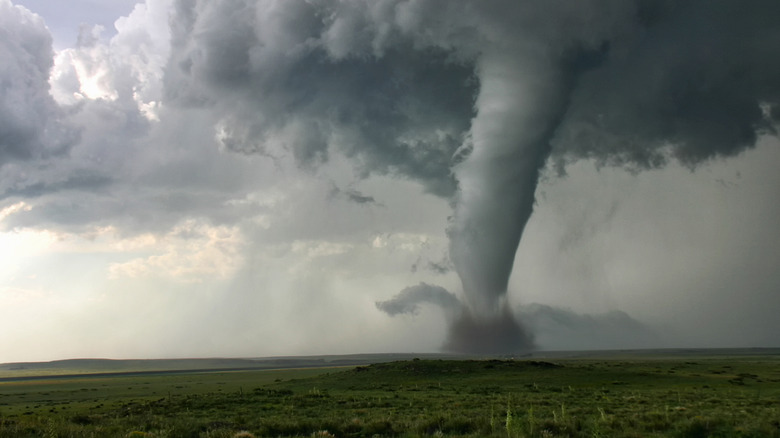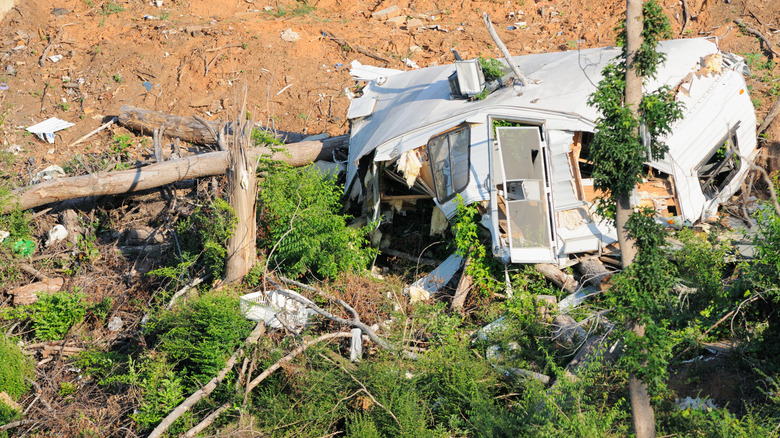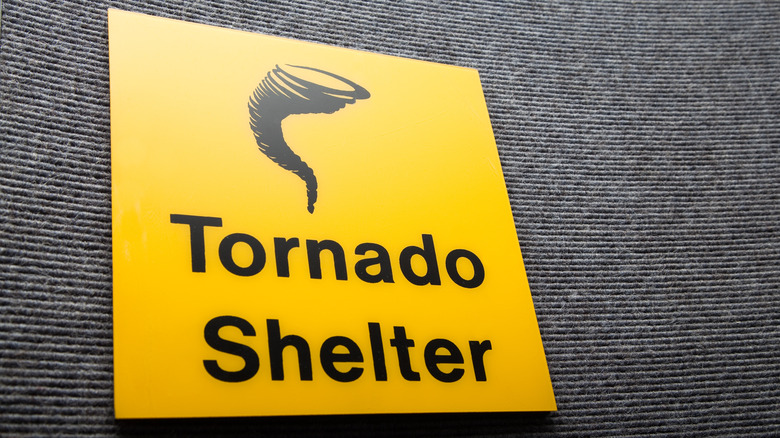What Happens When You Get A Tornado Alert At A Campground?
You're enjoying a blissful spring day camping lakeside at Toledo Bend Reservoir in East Texas, lounging in your hammock and watching the dogs play tug-of-war with a rope toy. Suddenly your phone makes a sound you've never heard before, an insistent wail. Picking it up, you see a notification with the headline "Emergency Alert." The message begins: "National Weather Service: TORNADO WARNING in this area until 3:30 PM CDT. Take shelter now in a basement or an interior room on the lowest floor of a sturdy building."
Leaping out of the hammock, you look over at your tent and see the nylon walls billowing in the building breeze. It does not qualify as a "sturdy building," nor does it have a basement. You're from the West Coast, and while you've driven through wildfires and atmospheric rivers, you don't know anything about tornadoes, except what you learned watching the "Wizard of Oz."
Reading on, the rest of the message advises, "If you are outdoors, in a mobile home, or in a vehicle, move to the closest substantial shelter and protect yourself from flying debris. Check media." You're miles from the nearest town, and you doubt that taking shelter in the Dollar General's basement is an option, even if you could make it there before the weather hits. Casting about, the only "substantial shelter" is the lone concrete outhouse, an 8 x 10 foot concrete bunker where the only place to sit is, well, the throne. What to do? Is this serious?
How seriously should you take a tornado warning?
According to the National Weather Service, there are three levels of emergency alerts regarding tornadoes. The lowest level is a Tornado Watch, which covers a broad area and means conditions are ripe for one. The second level is a Tornado Warning: "A tornado has been sighted or indicated by weather radar." You should stop doing whatever you're doing and get to safety. The third level, labeled Tornado Emergency, means that "a violent tornado has touched down in the watch area. There is a severe threat to human life and property, with catastrophic damage confirmed."
When you undertake a Route 66 road trip, you'll pass right through the middle of "Tornado Alley," comprising Texas, Oklahoma, Nebraska, and Kansas. Twisters are most likely to occur on spring and summer afternoons, but they can strike any time, day or night, and have occurred in all 50 states. In 2023, 1,197 confirmed twisters touched down across the U.S., resulting in 83 deaths across 12 states, numbers that are about average.
In the spring of 2024, a tornado ripped through an RV park in Denton County, Texas, flattening all 20 of the motorhomes and trailers there. Donald Wylie was inside his camper, trying to roll the bedroom slide-out in, when the twister struck. The wind picked up the RV, with Wylie inside it, flipping it right over the top of his tow vehicle. "It slammed into another camper, and it exploded," Wylie told CBS News at the time. "How I survived, I have no idea."
Preparing for tornado season
All the usual advice for camping during stormy weather applies in tornado country, with some additions. While you might ride out a lesser storm in an RV, the most dangerous place to be in a tornado is a motor vehicle — and that includes a camper or motor home. The National Weather Service advises you to " abandon your car and seek shelter in a low lying area such as a ditch or ravine." If you receive a tornado warning on your way to the campground, or spot one on the horizon, do not try to outrun it. Also, do not be tempted to park under a bridge or overpass to ride it out, thinking this will provide some measure of shelter and protection. The opposite is actually true: A bridge acts as a funnel, intensifying winds, and you are in great danger of being sucked out from under a bridge during a tornado, according to meteorologists at Ohio State University.
One strategy for tornado season camping is to look for a campground with a tornado shelter. RVTravel.com maintains a list of campgrounds that offer them. Are shelters effective? In May 2024, a KOA campground in Claremore, Oklahoma was devastated by a tornado on Memorial Day Weekend. The storm killed 18 people, but no fatalities occurred in the campground, as it provided a tornado shelter.
If your campground doesn't have one, it turns out you can indeed shelter inside a concrete restroom. One Redditor reports surviving a tornado by doing just that, emerging to find their tent had blown away entirely: "I have gotten tornado warnings before but never took them seriously. Being out in the elements in that storm and almost dying has changed completely how I treat them."


